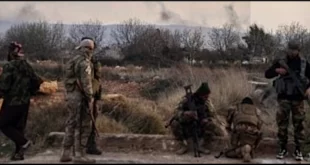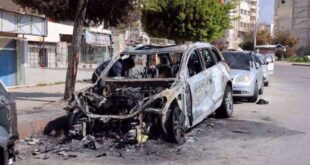March 22, 2017, Foriegn Affairs – Max Abrahms, Denis Sullivan, and Charles Simpson
Separating Fact From Fiction
The Syrian refugee crisis is the worst human security disaster of the twenty-first century. Beyond the death toll, which stands at around 400,000, an estimated 11 million Syrians—about half the national population—have fled their homes since the beginning of the conflict in March 2011. Prior to the evacuation of eastern Aleppo in late 2016, the United Nations High Commissioner for Refugees (UNHCR) reported that over six million Syrians were displaced inside the country; about five million refugees have fled to nearby Egypt, Iraq, Jordan, Lebanon, and Turkey; and nearly a million more have requested asylum in Europe, mostly in Germany. This crisis is not only a matter of life and death for millions of Syrians but is consequential to Syria’s immediate neighbors and to much of the rest of the world.
Yet a lack of direct evidence from the field has spawned speculation, misinformation, and poorly informed policymaking. In response to this informational deficit, a seven-person research team from Northeastern University was deployed along the western Balkan migration route into Europe (see map below) to speak with Syrian migrants, learn how and why they have left their country, and study the consequences of their migration to themselves and to Europe. Members of the research team spoke Arabic, were natives of or had spent substantial time in the countries in which they operated, and had been trained to interact with vulnerable migrant communities.
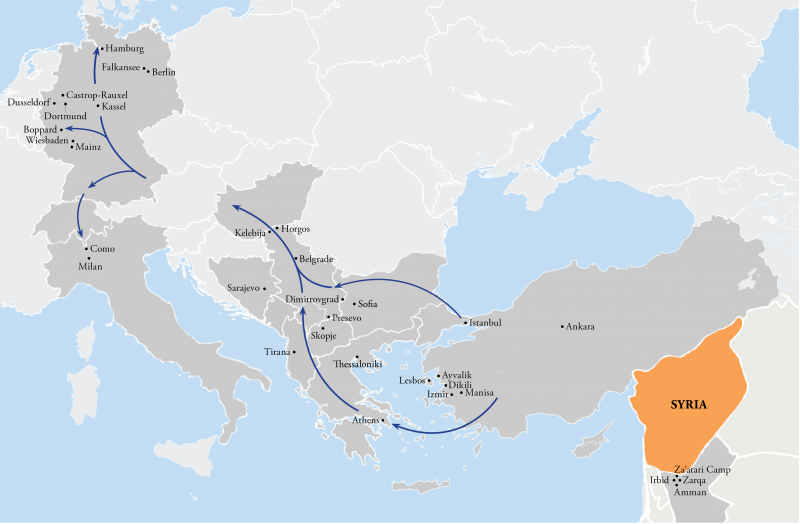
Unlike previous studies, which have relied on questionnaires in a single country such as Lebanon or Germany, our team conducted detailed, comprehensive interviews in numerous locations along the Balkan route, albeit with a smaller number of refugees. The interviews, done mainly during the summers of 2015 and 2016, were conducted at refugee camps, border crossings, checkpoints, cities, and smuggler boat launch sites in departure countries (Jordan, Turkey), transit countries (Albania, Bulgaria, Greece, Hungary, Italy, Macedonia, Serbia), and destination countries (Belgium, Germany).
Our sample of 130 Syrian refugees does not purport to be representative, but it was carefully selected to include variation with respect to age, gender, socioeconomic background, formal education level, religion, political affiliation, region of origin, and travelling variables such as group size, presence or absence of family members, and location on the migrant route. For added confidence, information from these interviews was triangulated with ethnographic notes from each site, third-party government and NGO data sets, and supplemental meetings with aid workers, security personnel, government representatives, and local community leaders. The results of this fieldwork challenge five commonly held myths about the refugees.
MYTH ONE: MOST SYRIAN REFUGEES ARE FLEEING ASSAD
Conventional wisdom holds that Syrian President Bashar al-Assad holds primary, if not sole, responsibility for the refugee crisis. Although the Islamic State (ISIS) may grab the headlines, the Western media presents the Alawite dictator as the real menace to the Syrian people and to the armed opposition that is protecting them. “Assad Regime Fans Refugee Crisis,” warned The Wall Street Journal in September 2015. The Washington Post similarly explained the “exodus” of Syrians from their country by noting that “Islamic State has killed many Syrians, but Assad’s forces have killed more.”
Yet does Assad really bear all the blame for the refugee crisis? Not according to Syrian refugees. Most refugees we spoke to said they felt endangered by all parties fighting in the war, not just the government. In our sample of Syrian refugees, only 16 percent lay the blame exclusively with the Assad regime, compared to 77 percent who said they were fleeing from both the regime and the armed opposition. This pattern was observed in every country along the Balkan route.
Only 16 percent of Syrian refugees lay the blame exclusively with the Assad regime, compared to 77 percent who said they were fleeing from both the regime and the armed opposition.
Take the example of Abdullah, a 40-year-old interviewed in the Serbian town of Horgos, along the border with Hungary, who asked that his real name not be used. Abdullah was initially kidnapped in Damascus by Jabhat al-Nusra (also known as Jabhat Fatah al-Sham), al Qaeda’s Syrian affiliate. After Nusra released him, the Assad government imprisoned him for suspected collusion with the rebels. Seeing threats from both sides, Abdullah fled the country with his wife and children. A 30-year-old refugee in the Fatih neighborhood of Istanbul shared a similar experience and said, “There was no one left to trust, which is why I left.” Fear of all sides was the norm. Another refugee, a 34-year-old man with whom we spoke in Dortmund, Germany, had also been kidnapped by Nusra and then arrested by the government. “Torture was more [severe]” under Nusra, he said. A 21-year-old student from Aleppo said that she felt unsafe only after the Free Syrian Army “took control of [her] area,” because she was then exposed to a dual hazard: harm from the rebels and the possibility of a bombing by the Syrian air force. Another refugee, a 31-year-old interviewed in Athens, told us of how grateful he and his brother were when the Syrian army chased ISIS from their neighborhood in Deir ez-Zor, but explained that the situation nonetheless remained too unstable for them to continue living there.
In sum, in-depth conversations with Syrian refugees along the Balkan route and within the EU suggest they are fleeing not only, or primarily, from Assad, but from a complex civil war with multiple belligerents who all pose a threat to the population. The “blame-Assad only” narrative may resonate, but most refugees count him as one of several culprits, alongside the rebels and ISIS.
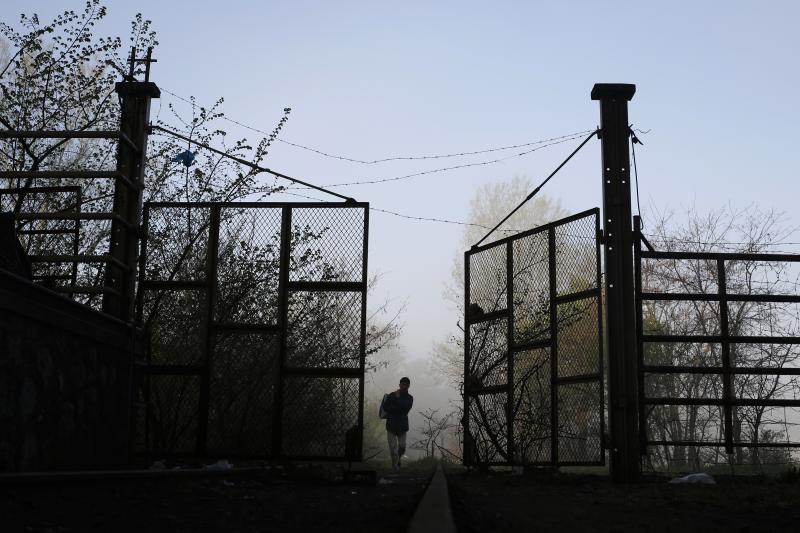
MYTH TWO: IT’S HARD FOR SYRIAN REFUGEES TO ENTER EUROPE
Policymakers in the EU and Turkey assure their citizens that new security measures, such as additional border fences, checkpoints, and land and sea patrols, effectively block refugees from reaching Europe illegally. Frontex, the EU border security agency, has called its “enhanced border security measures” a “success,” and EU Council President Donald Tusk has gone so far as to say, “The days of irregular migration to Europe are over.” But what do Syrian refugees have to say about the new security?
Refugees stressed how easy it is to bypass the EU’s new security measures. There remain expansive swaths of rural terrain where Syrians can easily walk across national boundaries; indeed, members of our team were taken to several unmanned crossings along the Turkish, Greek, Bulgarian, Macedonian, Serbian, and Hungarian borders. Some refugees use cornfields to cover their movement and low-tech tools such as wire cutters to get through fences. Even at heavily fortified areas along the border, refugees are often able to cross after a process of trial and error. But in our sample, 75 percent of the refugees interviewed said that they had crossed into the EU on their first attempt. Of course, it’s possible that a large portion of Syrian refugees never make it out of the country even after multiple attempts. But the refugees who did make it stressed the ease of bypassing the new security measures, especially for those who can afford a smuggler.
75 percent of the refugees interviewed said that they had crossed into the EU on their first attempt.
In fact, 60 percent of the refugees we spoke to travelled without any form of documentation at all. A a 22-year-old male refugee in Athens said, “No one looked at my documents.” A 21-year-old male refugee, who passed from Macedonia into Serbia through the Presevo checkpoint, likewise noted the lack of concern from the border guards. “They don’t need to see your passport,” he said. “They don’t care about your visa or anything.” Interviews with Presevo security experts support the refugees’ depiction of the border closures as largely symbolic.
Even without travel documents, many refugees said that they were usually processed by untrained police or Coast Guard officers in under ten minutes. Background questions put to refugees were perfunctory. A 27-year-old Syrian refugee in Frankfurt described his security interview in Germany as “silly.” He was asked whether he had killed anyone or participated in “political extremist stuff like ISIS or whatever.” He said that he had replied with a laugh, “No, I didn’t kill anyone. I’m [an] angel.” Bribery at border crossings is especially rampant. A 21-year-old refugee in Falkensee, Germany, told us that in September 2015, for ten euros per person, he and his traveling companions from Syria, Iraq, and Central Asia bribed Serbian policemen into getting them a ride across the border.
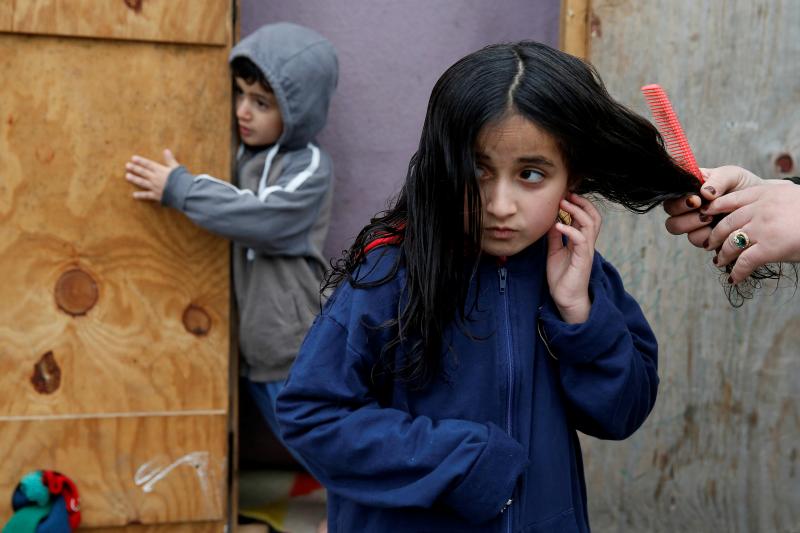
MYTH THREE: REFUGEES MUST BE PROTECTED FROM SMUGGLERS
Most Syrian refugees who reach the European Union use a smuggling network. Interpol, Europol, and the European Commission promote the widespread view that border security personnel protect refugees from these smugglers, who are generally characterized as predatory, if not downright evil. As Europol Director Rob Wainwright puts it, “Europol has been at the forefront of supporting Member States in fighting the criminal networks that exploit desperate migrants.” The international media contribute to this narrative as well. The New York Times ran a story with the headline “The Refugee Crisis Has Produced One Winner: Organized Crime,” and USA Today told readers that “good fortune” for the smugglers comes “at the expense of the migrants.” Lost in this apparent consensus is what the refugees say about the smugglers.
Instead of seeing their smugglers as exploiters, refugees tended to express gratitude toward them, while describing European security personnel as cruel and often abusive. In our sample, 75 percent of refugees said they were either “satisfied” or “very satisfied” with their smuggler experience, compared to only 16 percent who said they were either “dissatisfied” or “very dissatisfied.” (Nine percent were neutral.) A middle-aged mother who crossed the Syrian-Turkish and Turkish-Greek borders described the man who helped her as “very helpful.” She admitted being “taken advantage of in terms of money,” but said, “I wasn’t mistreated.” A 20-year-old male refugee in Serbia likewise said his smuggler wanted to “grab some money,” but at no point tried to cheat or harm him or his daughter. “He insured her safety,” he said. Such stories were retold by many of the refugees who had travelled along the Balkan route. Of course, there are also some cases of exploitation. But most refugees from our sample characterized smugglers fondly and thanked them for providing a life-saving service.
Refugee views of security personnel, both in and outside of Europe, were far worse. An elderly refugee in the Diavata camp near Thessaloniki, Greece, recalled how the Turkish police had imprisoned her and shot at other migrants. Another refugee, also interviewed near Thessaloniki, said that Turkish soldiers beat and threatened to kill Syrians.Similar stories were told in Elliniko about the Greek authorities. In Sofia, Bulgaria, our team observed grotesque conditions, such as broken washroom facilities and flooded hallways in government-administered camps, which were essentially run-down prisons. Refugees reported being attacked by vigilantes in the southeast of the country, perhaps with the blessing of the government. The vigilantes warned them, “Remember the name of this place—Bulgaria! And tell your friends not to come here!” Further along the Balkan route in Horgos, a Syrian refugee told us of her group being robbed and beaten by the Bulgarian police.
Detailed testimonies of refugees along the Balkan route therefore challenge the conventional wisdom that officials tend to protect them from raptorial smugglers. Based on our research, refugees seem to view the smugglers as allies, while security officials are generally seen as callous, hostile, and even dangerous.
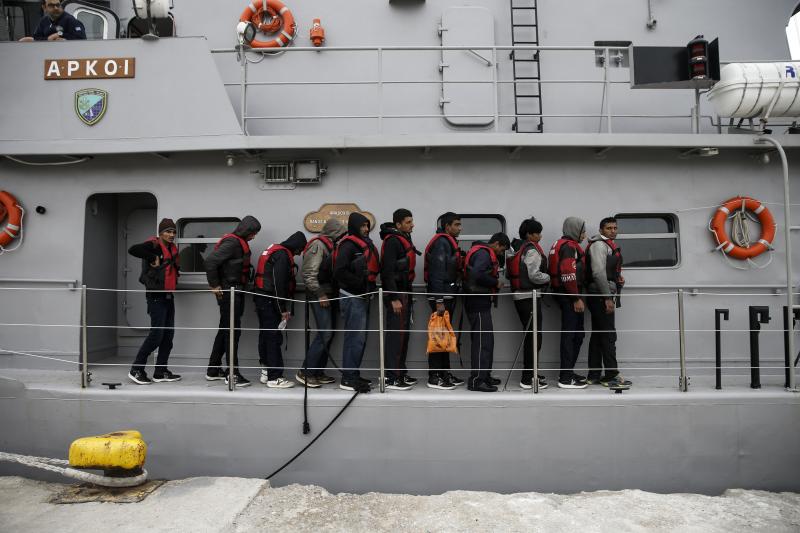
MYTH FOUR: CRACKING DOWN ON SMUGGLERS HELPS REFUGEES
Since the onset of the refugee crisis, the EU has introduced a suite of countermeasures against smugglers, allegedly to help protect Syrian refugees and to block potential terrorists from entering Europe. By patrolling sea routes and border crossings, EU agencies like Frontex have tried to deter smugglers by arresting them, seizing their boats, and otherwise raising the costs of illegally transporting Syrians into Europe.
Officially, this strategy has proved successful. In testimony to the British Parliament, Richard Lindsay, then the head of the Security Policy Department of the United Kingdom’s Foreign and Commonwealth Office, concluded that thanks to EU countermeasures, “smuggling networks … can no longer operate with impunity.” A spokesperson from one of the anti-smuggling operations, Operation Sophia, has echoed this rosy assessment. The main externality of punishing the smugglers, however, has been a steep rise in the cost of their services—a rise that disproportionately harms the poorest refugees rather than comparatively wealthy terrorists. Our research team found that between May 2015 and May 2016, the average price for an individual Syrian refugee to flee to Europe increased by about 488 euros, and the price for a family increased by 3,657 euros.
As a result of this price increase, countless destitute refugees now complain about being stuck at border crossings along the migrant route. A lack of money is nearly always the sole impediment for refugees looking to enter Western Europe. And despite tighter EU security, smugglers still abound for those who can afford them. Our team observed thriving smuggler businesses in major cities in Austria, Greece, Hungary, Serbia, and Turkey. In Basmane, a smuggling hub in the Turkish city of Izmir, a 20-year-old Syrian refugee laughed when asked if it had become challenging to find smugglers. “There are hundreds,” she said. “If you go to eat at any restaurant, [smugglers] come to you [and ask], ‘Do you want to go to Europe?’”
With support from militant groups funded by the Gulf states, terrorists are less affected by the soaring costs of smuggling. A former Nusra fighter based in Izmir bragged about crossing the Syrian border with impunity, taking respite in Turkey before returning to the frontlines. Aid workers in border cities corroborated these claims, describing fighters travelling unencumbered across the Syrian-Turkish border. Smugglers have even admitted to loading up terrorists on ships bound for Europe, a point of pride in Islamic State propaganda.
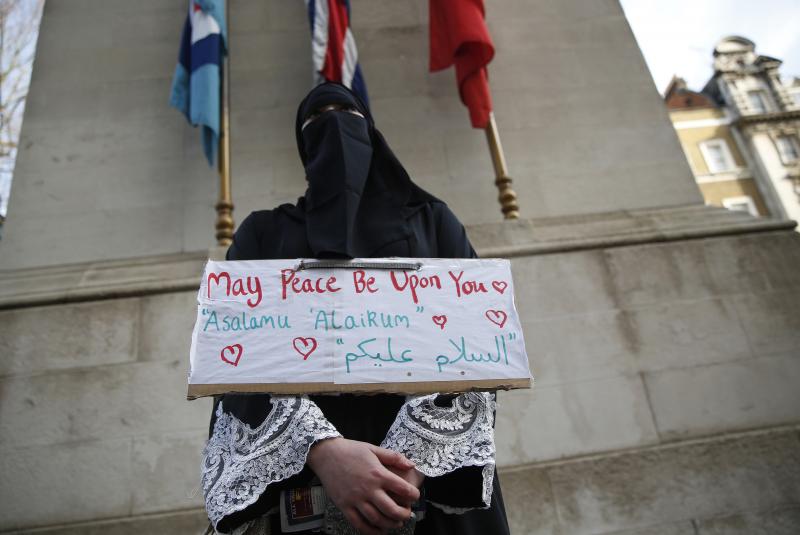
MYTH FIVE: CULTURAL DIFFERENCES PREVENT INTEGRATION
A final myth is that Syrian refugees cannot integrate into Europe because of their cultural differences. The charge, by now familiar, is that the predominantly Muslim refugee population has illiberal, even dangerous cultural values, which will lead to rising crime rates and the threat of terrorism and sexual violence in Europe. Right-wing politicians have played on this fear, warning that the influx of Muslims into Europe will inevitably lead to a clash of civilizations. Marc Vallendar, of the German right-wing Alternative für Deutschland party, posted on Facebook in early 2017 about the folly of taking in refugees. “There are plainly and simply fundamental cultural differences between Europe and the Middle East,” he wrote. “Not for nothing are these countries all engulfed in flames.” And Marine Le Pen, the French leader of the anti-immigration National Front, has likened the influx of Syrian refugees to the barbarian invasions that destroyed the Roman Empire.
Given that refugees indeed came from another culture, we expected them to express strong misgivings about Europe and its culture. Two-thirds of the refugees in our sample did express dissatisfaction with their host country, but usually not for cultural reasons. The refugees were asked to describe their main difficulties adjusting to life outside of Syria. More specifically, they were prompted to explain how their transition was going and what their biggest impediments were. Only 27 percent directed their frustrations toward European culture, compared to 38 percent whose complaints focused on mistreatment by specific European governments, or else on the policy failures of multinational institutions, such as the UN’s inadequate distribution of relief aid.
Many Syrian refugees were emphatic that their problem with Europe is not the culture. A 31-year-old refugee in Ankara’s Dogantepe neighborhood described how most Syrians are actually quite used to embracing diversity: “Syrian people are really, really, really open people. They can really live with any sect, with any religion, with Christian[s] or whatever.” In fact, our team found that some refugees were most upset with the ethnically Turkish, Pakistani, and Moroccan Muslim officials running the European camps, because their reading of Islam was seen as too radical. A 25-year-old refugee in Mainz, Germany, told us that the issue is not the “European lifestyle,” since even his Christian refugee friends are miserable.
Refugees exhibit a sophisticated understanding of where to direct blame for their hardships. For instance, a middle-aged refugee was wrongfully detained as a smuggler by the Greek Coast Guard, but he calmly assailed the EU policies—not the Greeks more generally—for the mistake. A 25-year-old refugee lamented his experiences in Greek and Macedonian camps. He blamed his months of suffering neither on Greece nor Macedonia but on Brussels and Geneva for insufficiently supporting the efforts of poor Balkan countries.
Admittedly, a few refugees confided that they knew of others struggling to integrate due to cultural differences. One young man in Berlin acknowledged, for example, that some refugees “unfortunately … are not willing to be open to the place they came to.” But when refugees brought up culture, it was usually to complain of discrimination at the hands of Europeans. Especially in Turkey, refugees are targets of xenophobia. A 24-year-old male Syrian refugee in the migrant-dense neighborhood of Fatih, Istanbul, said that some Turkish guards “are a little racist, we found a few.” He added later, “We suffered as Syrians. I suffered personally from this racism.” Most refugees were quick to note, however, that racism is not a Europe-wide problem but one of “individual cases.”
Refugees expressed no desire to retaliate with violence. In fact, they complained how terrorism was politically counterproductive for Muslims—a point substantiated in copious empirical studies within the terrorism literature. A refugee in Germany said, “Because of certain things that are happening in the world, like the bombings, like the extremists,” there had been a backlash against the refugees. “It really affects the image of Syrians in the eyes of Germans,” he said. “There is resentment toward Syrians, even though at the beginning they were really welcome. But now, things are a bit different.” The fear of being wrongly labeled as a “terrorist” is so widely held among refugees that many say their peers in Syria are staying put.
POLICY IMPLICATIONS
Myth-based policies are seldom successful, yet that is what the EU has offered to date. Having debunked five myths about Syria, we offer several policy prescriptions based on the reality uncovered along the Balkan route.
First, the international community should be even more selective about which militant groups it backs in Syria. Western support for the opposition has exacerbated the war, fuelling a cycle of violence that has trapped Syrian civilians between the government and its adversaries.
Second, security forces should invest in refugees to help vet out potential terrorists. Refugees are an underutilized counterterrorism resource because they have a strong self-interest in stopping terrorism and know others in their cohort.
Third, abusive border and security officials should be identified and punished. Balkan countries have oversight administrators for these purposes. But the ombuds offices are generally understaffed and toothless. These administrators should be backed up with more EU observers to credibly threaten punishments against governments that fail to comply with basic humanitarian expectations.
Fourth, governments should coordinate with private sector transportation firms to provide safer, less expensive migration options as an alternative to smugglers. The goal should not be to increase the number of refugees but to help protect them.
Fifth, refugee integration should focus on overcoming pragmatic barriers like poor housing and unemployment rather than the overstated cultural clash. Governments, for instance, could implement more flexible hiring practices that do not require refugees to pass difficult language requirements when their existing skill set is sufficient for the job.
This field work along the Balkan migrant route sheds new light not only on how the EU should adjust its responses to the refugee crisis but also on why so many refugees have been created in the first place.
Share this:
- Click to share on Twitter (Opens in new window)
- Click to share on Facebook (Opens in new window)
- Click to share on Reddit (Opens in new window)
- Click to share on WhatsApp (Opens in new window)
- Click to share on Tumblr (Opens in new window)
- Click to email a link to a friend (Opens in new window)
- Click to print (Opens in new window)
 Syria Support Movement solidarity with the Syrian people
Syria Support Movement solidarity with the Syrian people



